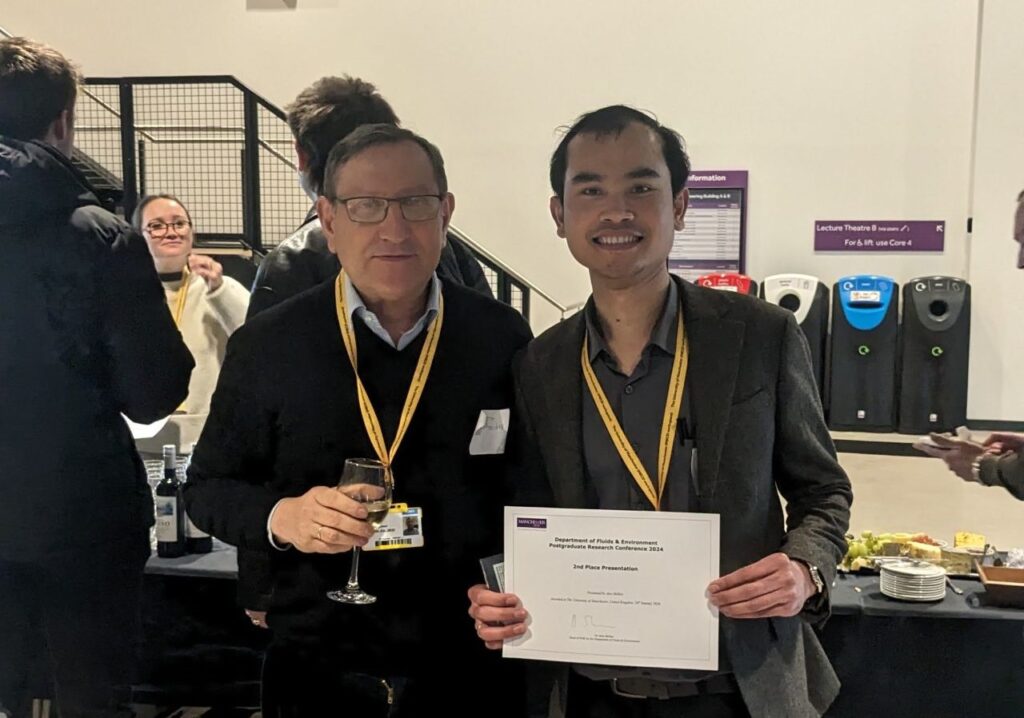Politeknik Negeri Semarang (Polines) lecturer, Bayu Sutanto, won a number of awards for his innovation in passive cooling systems for floating solar power plants (PLTS). This floating PLTS is claimed to be able to reduce temperatures significantly and increase electrical power to 17,84%. This innovation has also succeeded in opening up new opportunities in the field solar engineering.
Apart from being a Polines lecturer, Bayu Sutanto is also a doctoral student at the University of Manchester, England. Bayu won a number of awards for his innovation, including Best PhD Presentation at the Department of Fluid and Environment Postgraduate Research (PGR) Conference, University of Manchester and the award for best briefing paper at the International Summer School in Global Just Transition program by the UK Energy Research Center (UKERC). Another award is Best Poster and Presentation at the Department of Mechanical, Aerospace and Civil Engineering (MACE) PGR Conference, University of Manchester in 2022.
Bayu's innovation idea was also the only research that won more than two awards at once events annually at the Osborne Reynolds Campus (the originator of the Reynolds number). The complete results of this idea have also been published in prestigious international journals in the International Journal of Thermal Sciences, Elsevier in 2022 and in Applied Thermal Engineering, Elsevier in 2024.
Reducing Costs
This innovation developed by Bayu Sutanto was motivated by temperature constraints in solar cells in floating solar power plants which are considered very crucial and continue to be a concern for researchers because they can reduce the efficiency and lifespan of solar cells. So far, to overcome this problem, a system of spraying water with an electric pump on the surface of the solar panels has been widely used to cool the temperature of the solar cells when the sun is hot.
"However, because it uses an electric pump, this cooling system creates an additional electrical burden for the floating PLTS system. "This is what we have to find a solution for," said Bayu.
Bayu also tried to innovate by developing a passive cooling system for floating solar power plants. This innovation idea was carried out using a numerical approach and validated with several experimental activities in collaboration with the Bandung Institute of Technology and Semarang State Polytechnic to adjust the character of sunlight in Indonesia. This cooling system utilizes the properties of water which will change its density when the temperature rises so that a buoyancy force can be formed which moves the water fluid naturally.
"This system is able to reduce the temperature significantly and increase the electrical power of the floating PLTS to 17,84% when under solar radiation of 1000 W/m2 without requiring a water pump or external electrical energy," added Bayu.

Furthermore, Bayu hopes that this system can be applied to floating PLTS built in Indonesia. Examples include the floating PLTS in Cirata, West Java with 145 MW which will be the largest floating PLTS in Indonesia, then the floating PLTS in Singkarak, West Sumatra with 50 MW, and the floating PLTS in Saguling, West Java with 60 MW.
For information, Bayu is the recipient of the Indonesian Education Scholarship (BPI) in 2022 from the Ministry of Education, Culture, Research and Technology (Kemendikbudristek) and LPDP to continue his doctoral studies in England. Currently, Bayu Sutanto is a student in the Mechanical Engineering PhD program at the School of Engineering, University of Manchester.
Apart from being a doctoral student, Bayu Sutanto is also active as a doctor graduate teaching assistant who teaches several courses in the Mechanical and Aerospace Engineering Study Program for undergraduate students at the University of Manchester, such as fluid mechanics, heat transfer and thermodynamics.

Bayu's interest in research on floating solar power plants is recognized by the continuing increase in the need for renewable energy sources and the increasing number of solar power plants being built in the world.
“Generally, large-scale PLTS are built by opening new land and will directly impact forest or agricultural land. "This has been able to be overcome with the floating PLTS concept which uses the open surface of reservoirs, swamps or lakes so that it can minimize the need for land investment," said Bayu. (Polines/Nan/Cecep)
source: vokasi.kemdikbud.go.id

